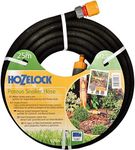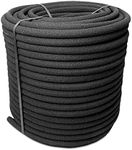Buying Guide for the Best Soaker Hoses
Choosing the right soaker hose for your garden can make a significant difference in the health and growth of your plants. Soaker hoses are designed to deliver water directly to the roots of your plants, ensuring efficient water usage and promoting deep root growth. When selecting a soaker hose, it's important to consider several key specifications to ensure you get the best fit for your gardening needs.MaterialSoaker hoses are typically made from rubber, vinyl, or a combination of both. Rubber hoses are more durable and can withstand higher water pressure, making them ideal for larger gardens or areas with rough terrain. Vinyl hoses are lighter and more flexible, which can be beneficial for smaller gardens or intricate layouts. If you need a hose that will last longer and handle more wear and tear, opt for rubber. For ease of use and flexibility, vinyl might be the better choice.
LengthThe length of the soaker hose you need depends on the size of your garden and the layout of your plants. Soaker hoses come in various lengths, typically ranging from 25 to 100 feet. For small gardens or specific plant beds, a shorter hose will suffice. For larger gardens or multiple plant beds, you may need a longer hose or multiple hoses connected together. Measure the area you need to cover and choose a hose length that will adequately water your plants without leaving dry spots.
DiameterThe diameter of a soaker hose affects the water flow rate. Common diameters are 1/4 inch, 1/2 inch, and 5/8 inch. A smaller diameter hose (1/4 inch) will deliver water more slowly and is suitable for delicate plants or areas where precise watering is needed. A larger diameter hose (5/8 inch) will deliver water more quickly and is better for larger areas or plants that require more water. Consider the water needs of your plants and the size of your garden when choosing the diameter.
Flow RateThe flow rate of a soaker hose determines how much water is delivered over a certain period. This is usually measured in gallons per hour (GPH). A higher flow rate means more water is delivered quickly, which can be beneficial for plants that need a lot of water. A lower flow rate is better for slow, deep watering, which encourages strong root growth. Assess the water requirements of your plants and choose a hose with a flow rate that matches those needs.
Pressure RatingSoaker hoses have a pressure rating that indicates the maximum water pressure they can handle, usually measured in pounds per square inch (PSI). Most soaker hoses work best at low pressure, around 10-30 PSI. Using a hose with a pressure rating that matches your water source will prevent damage to the hose and ensure efficient watering. If your water source has high pressure, consider using a pressure regulator to avoid damaging the hose.
UV ResistanceUV resistance is an important feature for soaker hoses that will be exposed to direct sunlight. UV-resistant hoses are treated to withstand the damaging effects of the sun, which can cause cracking and deterioration over time. If your hose will be in a sunny location, choose one with UV resistance to ensure it lasts longer and maintains its performance.



















